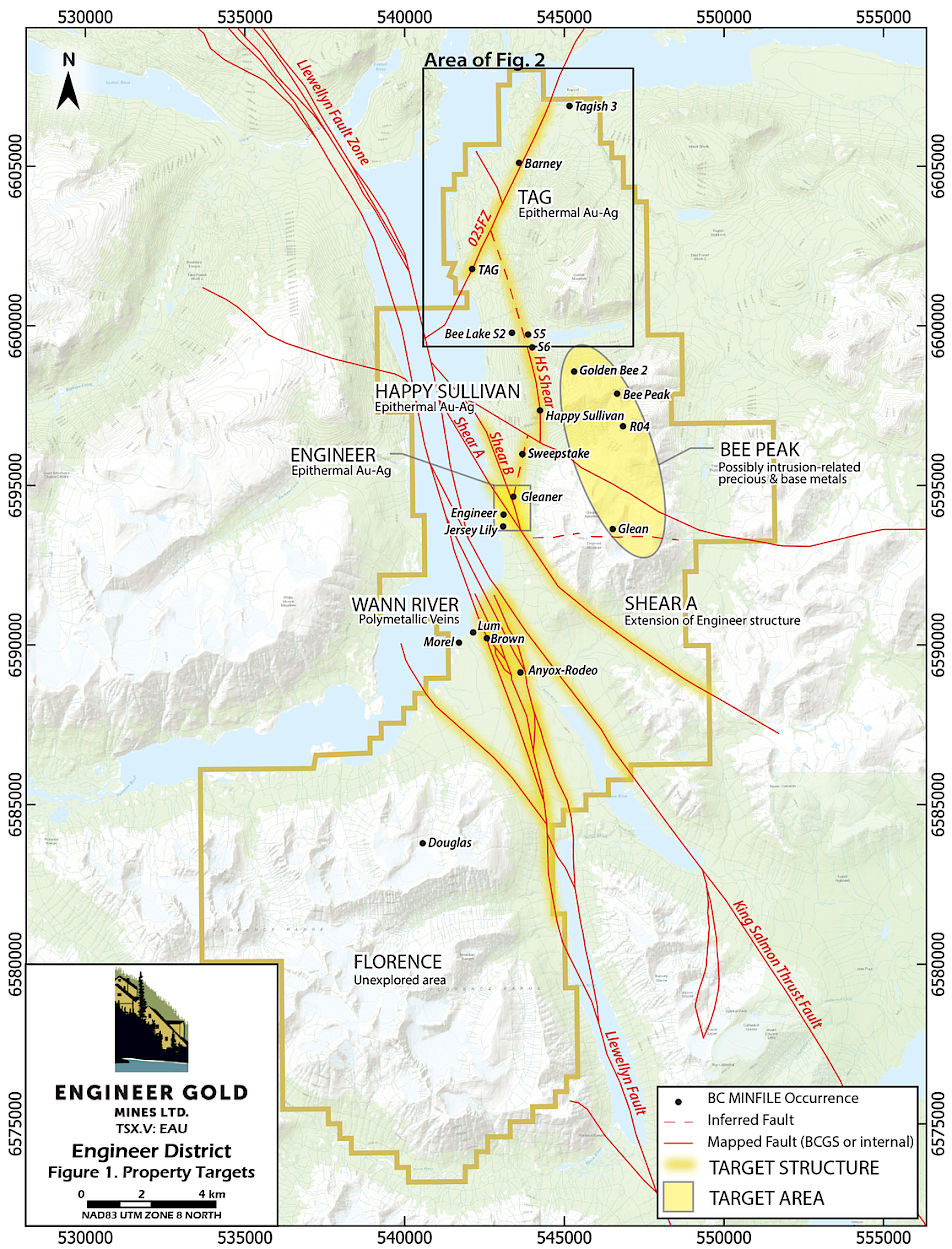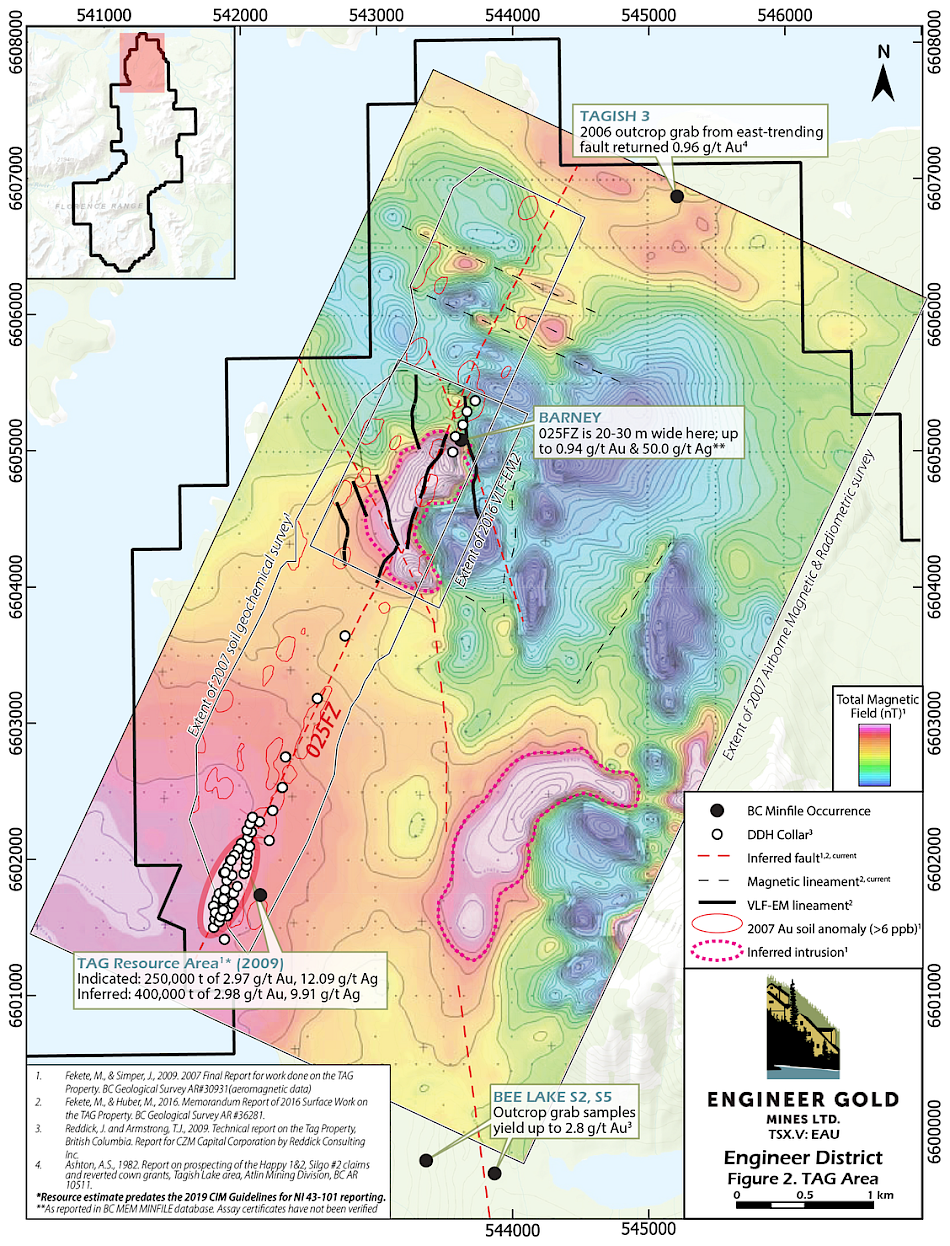Vancouver, BC – Engineer Gold Mines Ltd. (TSX-V: EAU; “the Company” or “Engineer”) is pleased to provide an update on its 100%-owned Engineer District property, which covers 29,593.47 hectares in a 35-km-long contiguous claim grouping near Atlin in northwest British Columbia. The Property was consolidated by the Company from 2018 – 2022, and includes the historical high-grade Engineer Gold Mine, the TAG developed prospect, and 17 additional known mineral occurrences. The Company is currently compiling prior owner and historical data in a way that has not been possible in the past due to fractured ownership. This holistic view of existing data is allowing the Company to identify exploration gaps and opportunities for development and discovery, which will continue to be released in the coming weeks as work progresses.
Chris Huggins, President & CEO of Engineer Gold Mines Ltd., stated “The existing geophysical and remote sensing data on the Engineer District property are valuable assets to assist in identifying targets including: possible oblique mineralized veins along the 025FZ, additional faults, and potentially mineralizing intrusions. Much of the existing geophysics data does not appear to have been followed up on, providing us with excellent opportunities for quickly developing and advancing targets.”
Mineralization in the TAG area occurs along a NNE-trending shear zone termed the 025FZ, which can be traced for 6.2 km across the northern portion of the Engineer District property (Fig. 1). Similarities exist between the 025FZ and Shear A, an important control on mineralization at the Engineer Gold Mine. Both structures are second-order splays of the metalliferous Llewellyn Fault, contain multi-phase quartz breccia zones with low-grade gold ranging from metres to tens of metres wide, and are continuous for more than one kilometre. At the Engineer Gold Mine, high-grade ore was mined from narrow dilational veins oblique to Shear A, however similar structures have yet to be discovered along the 025FZ.
Since its discovery in 1987, the TAG area saw limited exploration until 2006, when CZM Capital Corp. acquired the claims and completed soil geochemical sampling, an airborne geophysical survey, prospecting, surface trenching, and diamond drilling. A total of 11,519 m were drilled in 69 drillholes along the 025FZ, leading to a resource estimation along ~700 m of mineralization near the southwest extent (Fig. 2). A historical resource estimate contains 250,000 t of 2.97 g/t Au & 12.09 g/t Ag indicated and 400,000 t of 2.98 g/t Au & 9.91 g/t Ag inferred material **(Reddick & Armstrong, 2009). Of the 64 drillholes that intersected the 025FZ, only 19 drillholes of higher-grade intercepts were used in the resource estimation.
The authors of the technical report advised that potential exists for finding additional Au-Ag mineralization both below the current resource and along-strike and recommended the use of Induced Polarization (“IP”) surveys to refine targets for further drilling.
In 2016, Taku Gold Corp. conducted a Very Low Frequency Electro-Magnetic (VLF-EM) survey over the Barney occurrence and interpreted the data in conjunction with 2007 airborne magnetic and radiometric data (Fekete & Huber, 2016; Fekete & Simper, 2009; Fig. 2). The VLF-EM identifies three strong conductors along the 025FZ and five NNW-trending linear moderate to strong conductive lineaments considered prospective for follow-up work (Dubé, 2016; Fig. 2). Approximately 1900 m southeast of Barney, a magnetic high lineament trends subparallel to the 025FZ for ~1700 m (Fig. 2). Additionally, three WNW-trending magnetic high lineaments near the north end of the mapped 025FZ may represent fault zones similar to the east-trending fault tens of metres wide which yielded 0.96 g/t Au at the Tagish 3 showing (Davies & Justason, 2008).
The 2007 airborne survey also identified two probable intrusions, comprising kidney shaped magnetic highs with coincident elevated potassium counts (Fekete & Simper, 2009; Fig. 2). At Barney, drilling has confirmed that this geophysical feature represents a quartz-diorite stock, spatially and possibly genetically associated with mineralization. Previous workers have suggested that mineralization at Barney may represent an intrusion-related Au system or a deeper-seated extension of the TAG epithermal system (Pautler, 2021). The second geophysical feature, ~3 km south of Barney and 1.5 km east of Tag, has not yet been followed up.
In addition to the geophysical targets in the TAG area, strong Au-As-Sb soil geochemical anomalies delineate the 025FZ and occur sporadically on the periphery (Fekete & Simper, 2009; Fig 2). Prospecting and shallow trenching of the numerous geophysical and geochemical targets in the TAG area are recommended, to be followed by localized resistivity / IP surveys in preparation for drilling (Dubé, 2016).
**Resource estimates cited in this release predate the 2019 CIM Guidelines for NI 43-101 reporting and are historical in nature.
References
- Davies & Justason, 2007a. Technical report 2006 reconnaissance exploration program on the Tagish #3 mineral tenure. BC AR 28930.
- Dubé, J. 2016. Technical Report VLF-EM Ground Survey, Tagish Property. Prepared by Dynamic Discovery Geoscience for Taku Gold Corp. Within BC Geological Survey AR #36281.
- Fekete, M., & Simper, J., 2009. 2007 Final Report for work done on the TAG Property. BC Geological Survey AR #30931.
- Fekete, M., & Huber, M., 2016. Memorandum Report of 2016 Surface Work on the TAG Property. Operated by Taku Gold Corp. BC Geological Survey AR #36281.
- Reddick, J. and Armstrong, T.J. 2009. Technical report on the Tag Property, British Columbia. Report for CZM Capital Corporation by Reddick Consulting Inc.
Qualified Person
The technical content of this news release has been reviewed and approved by Sue Bird, M.Sc., P.Eng., independent consultant, a qualified person, as defined by National Instrument 43-101.
About Engineer Gold Mines Ltd.
Engineer Gold Mine: The historic Engineer Gold mine is a narrow vein past producing underground gold mine with an Inferred Mineral Resource of 41,000 t grading 19.0 g/t gold for 25,000 oz contained gold. The resource uses a cutoff grade of 5 g/t Au and assumes a 1m minimum mining width, which is similar to historical mining. It includes all material inside the mineralized shoots and is based on the payability (stope) limits. Within this resource is a higher-grade core of 14,000t grading 52.5 g/t gold (25 g/t gold Cut-Off) containing 23,600 oz contained gold. The resource grade was reconciled to a bulk tonnage sample which contained 175 tonnes at 23.9 g/t Au which is 16% higher than the resource grade of 20.6 g/t Au for the Engineer portion of the resource. This is considered acceptable for a nuggety gold deposit and exemplifies the potential conservatism of the 2018 resource. This resource estimate was initially calculated by Snowden Mining Industry Consultants Ltd. in 2011 and re-stated in the 2018 NI 43-101 Technical Report.
Note that this resource estimate predates the 2019 CIM Guidelines for NI 43-101 reporting. The Company has done no further work to confirm this historical resource.
Tag Property: The 1,070-hectare Tag property covers the 025 or Main zone, which contains an historical mineral resource estimate including 250,000 tonnes of Indicated material at average grades of 2.97 g/t Au and 12.09 g/t Ag, and an Inferred resource of 400,000 tonnes at average grades of 2.98 g/t Au and 9.91 g/t Ag. The resource estimate was calculated using the polygonal method with vertical section at 50m spacing, and grades composited over a minimum length of 2.0 meters. The Au was capped at a value of 4 g/t and Ag was capped at 25 g/t. Underground mining was assumed with all material having a minimum composited length of 2m, within the interpreted shapes and above the cutoff assumed to be amenable to underground mining. The cut-off grade used was 3.0 g/t gold equivalent, calculated with a silver to gold ratio of 59.927. This historical resource was published as an NI 43-101 report filed on SEDAR entitled "Technical Report on Resource Estimates for the Tag Property, Northern British Columbia", prepared for CZM Capital Corporation by Reddick Consulting Inc. and dated December 29, 2009. Note that this estimate predates the 2019 CIM Guidelines for NI 43-101 reporting. The Company has done no further work to confirm this historical resource.
Wann River: The Wann River project has seen grab samples from the Lum showing with up to 263 g/t Au and 1350 g/t Ag reported in 2010. Adjacent to the prolific Llewellyn fault, the Wann River project holds potential for significant further exploration and discovery.
On Behalf of the Board of Directors
Engineer Gold Mines Ltd.
“Christopher Huggins”
President & CEO
Tel: 604.968.4844
Cautionary Notes
Neither the TSX Venture Exchange nor its Regulation Services Provider (as that term is defined in policies of the TSX Venture Exchange) accepts responsibility for the adequacy or accuracy of this release. The TSX Venture Exchange has not reviewed the content of this news release and therefore does not accept responsibility or liability for the adequacy or accuracy of the contents of this news release.



